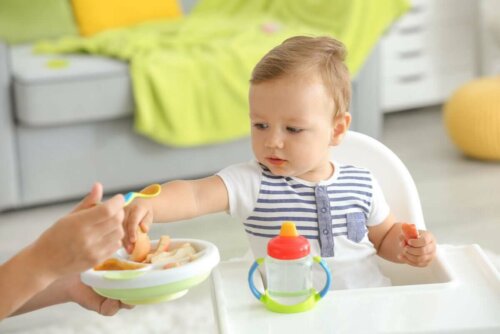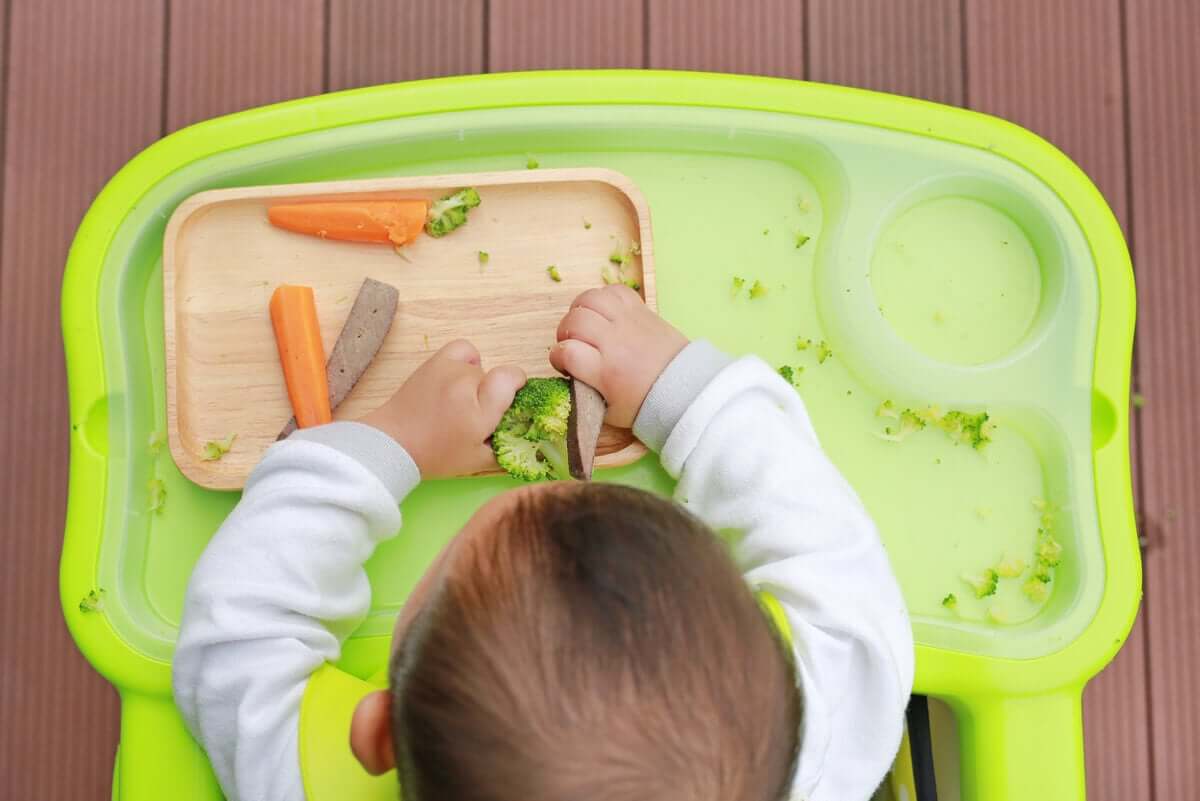All About Introducing Solid Foods to Babies

Introducing solid foods to babies is a delicate matter. It needs to be done gradually, when a baby is a few months old.
During pregnancy, the placenta plays a role in the nutrition of the fetus. Therefore, the baby’s digestive system must adapt after birth. This is the reason why newborns don’t tolerate all kinds of food.
In this article, we’ll tell you all about introducing solid foods to babies, how to know that your baby is ready for this, the recommended foods, and some general guidelines that you should take into account.
Introducing solid foods: How to know that your baby is ready
Babies should be breastfed exclusively during the first months of life. When your baby is six months old, you can start introducing solid foods. However, babies can continue to breastfeed up to the age of two, while simultaneously eating other foods.
In addition to age, a second element you need to take into account is related to height and weight. When babies are approximately four months old, they weigh twice as much as they did at birth. In some specific cases, the need to start introducing solid foods can be evaluated, although they’d be specific exceptions that a pediatrician should indicate.
Other aspects to consider are various signals babies’ bodies emit. The following indicate that a baby is ready to tolerate solid foods. For example, they:
- Can remain seated and hold their head up
- Show interest in food around them
- Open their mouths to take food into their mouths
- Make chewing gestures or movements

Read on to learn more: Breastfeeding and Female Sexuality
Recommended foods for this stage
You can include many different types of foods in your baby’s diet to start this new stage. However, some are more recommended than others. Some of them are:
- Cereals. Rice, oats, corn, or barley are foods rich in vitamins and minerals. In addition, they’re important sources of fiber.
- Vegetables. They’re rich in many different nutrients, even protein. You can make baby food with them.
- Fruits. They’re quite yummy on their own. You should preferably opt for fresh fruit, not canned.
- Foods of animal origin. Meat and fish are rich in protein, vitamin A, iron, zinc, phosphorus, and calcium. Regarding eggs, due to food allergies, experts recommend waiting until the baby is at least one year old to test their tolerance with a small portion.
- Legumes. They’re the best source of non-animal origin protein.
A related article you should read: Your Child’s Diet: Six Foods You Should Include in It
Introducing solid food to babies: how to do it
When it comes to introducing solid foods, it’s important to make sure that the baby doesn’t reject new foods. Although this can happen at the beginning, you have to keep at it.
In fact, you should administer small amounts of food. Remember that babies eat much less food than adults do. You need to give their digestive system enough time to adjust to the change. Thus, don’t get frustrated if they don’t eat much of the food.
Secondly, it’s easier to introduce solid foods by alternating with breastfeeding or formula. This means feeding your baby with a bottle or breastfeeding them, then giving them a teaspoon of food, and then more milk. This way, they’ll get used to the food.
During the process, the baby may play with the food. Sometimes, it’ll end up on their face, hands, bib, or floor, anywhere except their mouth.
Don’t scold your baby for it, as they could reject food the next time. On the contrary, you have to speak gently to them, encouraging them to eat. If your baby cries or doesn’t want to open their mouth, it’s best to wait instead of insisting.
Changes in babies when they start eating solid foods
When you start introducing solid foods, you’ll notice many changes in your baby. Their stools will be more solid, and their color and odor will also change. Similarly, their urine will become more cloudy.
Although some bowel movements may contain undigested food fragments, this shouldn’t alarm you. Bowel movement frequency can also vary, becoming less frequent. However, this isn’t a sign of constipation.
On the other hand, you’ll notice that, as your baby adapts to solid food, they’ll have a bigger appetite and eat bigger portions. Little by little, they’ll stop bottle or breastfeeding.
General infant feeding recommendations
Here are some simple recommendations you should consider once you begin introducing solid foods to your baby:
- Foods they can eat with their hands. Usually at this stage, you have to spoon feed your baby. Nevertheless, you should allow your baby to take the food in their hands and eat it themselves if they want. Simply make sure they aren’t taking big bites.
- Try other foods. Don’t give your child many different foods at once. In other words, it’s best to give them one food at a time. This way, you’ll know which foods they like the most. Today, try a cereal; tomorrow, a vegetable food puree.
- Fruit juice. You can make fruit juices that you can feed to your baby with a bottle, as long as the fruit is fresh. You shouldn’t add sugar to baby juices.

Not all solid foods are good for babies
Some parents may be concerned if their baby doesn’t eat much solid food at the beginning. But it’s perfectly fine for a baby to eat four ounces at first so they can adapt.
Some of the foods you should avoid feeding your baby are canned foods, cold cuts, preserves, popcorn, and other foods they can choke on. It’s essential to evaluate the size of the bites to avoid accidents.
Always try to puree or mash the foods so they can easily swallow them. Don’t give your baby anything whole. Finally, don’t add salt or seasonings, as they aren’t necessary for their palate. In fact, they can even increase the risk of chronic diseases.
All cited sources were thoroughly reviewed by our team to ensure their quality, reliability, currency, and validity. The bibliography of this article was considered reliable and of academic or scientific accuracy.
- De la Torre J. Pediatría accesible: guía para el cuidado del niño. México: Siglo XXI, 1998.
- Eisenberg A, Murkoff H, Hathaway S. El primer año del bebé. Bogotá: Norma, 2010.
- Organización Panamericana de la Salud. La alimentación del lactante y del niño pequeño: Capítulo Modelo para libros de texto dirigidos a estudiantes de medicina y otras ciencias de la salud. Washington: OPS, 2010.
- UNICEF. Estado Mundial de la Infancia. Niños, alimentos y nutrición: crecer bien en un mundo en transformación. Nueva York: UNICEF, 2019.
- UNICEF. Evaluación del crecimiento de niños y niñas. Argentina: Gobierno de la Provincia de Salta, 2012.
- Vallet M. Educar a niños y niñas de 0 a 6 años. Madrid: Wolters Kluwer, 2007.
- Walker W, Humphries C. Alimentación sana para niños. Barcelona: Paidós, 2011.
- Pérez-Escamilla, Rafael. “Evidence based breast-feeding promotion: the Baby-Friendly Hospital Initiative.” The journal of nutrition 137.2 (2007): 484-487.
- Pérez-Escamilla, Rafael, Sofia Segura-Pérez, and Megan Lott. “Feeding guidelines for infants and young toddlers: a responsive parenting approach.” Nutrition Today 52.5 (2017): 223-231.
- Madani, Shailender, Lisa Tsang, and Deepak Kamat. “Constipation in children: a practical review.” Pediatric annals 45.5 (2016): e189-e196.
- Bournez, Marie, et al. “Use of added sugar, salt and fat in the first year in France and associated factors in the ELFE cohort study.” 5. international conference on Nutrition and growth. 2018.
This text is provided for informational purposes only and does not replace consultation with a professional. If in doubt, consult your specialist.








